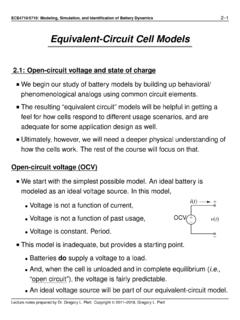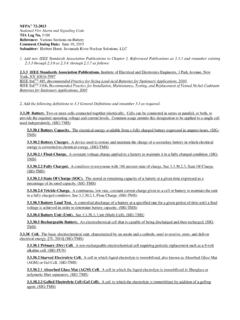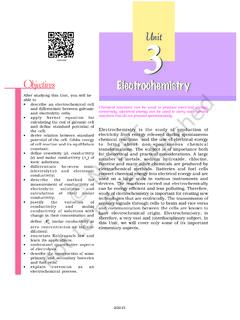Transcription of Electrochemical Impedance Spectroscopy - Gamry
1 Introduction to Electrochemical Impedance Spectroscopy Gamry Instruments Impedance The term Impedance refers to the frequency dependant resistance to current flow of a circuit element (resistor, capacitor, inductor,etc.) Impedance assumes an AC current of a specific frequency in Hertz (cycles/s). Impedance : Z = E /I E = Frequency-dependent potential I = Frequency-dependent current Ohm s Law: R = E/I R = Impedance at the limit of zero frequency Reasons To Run EIS EIS is theoretically complex (and can be expensive) why bother? The information content of EIS is much higher than DC techniques or single frequency measurements.
2 EIS may be able to distinguish between two or more Electrochemical reactions taking place. EIS can identify diffusion-limited reactions, , diffusion through a passive film. EIS provides information on the capacitive behavior of the system. EIS can test components within an assembled device using the device s own electrodes. Making EIS Measurements Apply a small sinusoidal perturbation (potential or current) of fixed frequency Measure the response and compute the Impedance at each frequency. Z = E /I E = Frequency-dependent potential I = Frequency-dependent current Repeat for a wide range of frequencies Plot and analyze Excitation and Response in EIS TimeMagnitudeApplied VoltageMeasured CurrentPhaseShiftVoltage MagnitudeCurrent MagnitudeEIS Data Presentation EIS data may be displayed as either a vector or a complex quantity.
3 A vector is defined by the Impedance magnitude and the phase angle. As a complex quantity, Ztotal = Zreal + Zimag The vector and the complex quantity are different representations of the Impedance and are mathematically equivalent. Vector and Complex Plane Representations of EIS Vector Complex Plane Real Impedance , Z Imaginary Impedance , Z = Phase Angle EIS data may be presented as a Bode Plot or a Complex Plane (Nyquist) Plot Freq (Hz)Log Modulus (Ohm) (Degree) + + + + + + + + + + + + + +03 Real (Ohm)-Imag (Ohm)Bode Plot Nyquist Plot Bode Plot Individual charge transfer processes are resolvable. Frequency is explicit.
4 Small impedances in presence of large impedances can be identified easily. Nyquist Plot Individual charge transfer processes are resolvable. Frequency is not obvious. Small impedances can be swamped by large impedances. Nyquist vs. Bode Plot Analyzing EIS: Modeling Electrochemical cells can be modeled as a network of passive electrical circuit elements. A network is called an equivalent circuit . The EIS response of an equivalent circuit can be calculated and compared to the actual EIS response of the Electrochemical cell. Frequency Response of Electrical Circuit Elements Resistor Capacitor Inductor Z = R (Ohms) Z = -j/ C (Farads) Z = j L (Henrys) 0 Phase Shift -90 Phase Shift 90 Phase Shift j = -1 = 2 f radians/s, f = frequency (Hz or cycles/s) A real response is in-phase (0 ) with the excitation.
5 An imaginary response is 90 out-of-phase. EIS of a Resistor TimeMagnitudeApplied VoltageMeasured CurrentPhaseShift of 0 EIS of a Capacitor TimeMagnitudeApplied VoltageMeasured CurrentPhaseShift of 90 Electrochemistry as a Circuit Double Layer Capacitance Electron Transfer Resistance Uncompensated (electrolyte) Resistance Randles Cell (Simplified) Bode Plot Freq (Hz)Log Modulus (Ohm) (Degree)Phase Angle Impedance Ru Ru + Rp RU RP CDL Complex Plane (Nyquist) Plot + + + + + + + + + + + + + +03 Real (Ohm)-Imag (Ohm)Ru Ru + Rp High Freq Low Freq RU RP CDL Nyquist Plot with Fit + + + + + + + + + + + + + +03 Real (Ohm)-Imag (Ohm)
6 Results Rp = +03 +01 Ru = +02 +00 Cdl = 7E-09 Other Modeling Elements Warburg Impedance : General Impedance which represents a resistance to mass transfer, , diffusion control. A Warburg typically exhibits a 45 phase shift. Open, Bound, Porous Bound Constant Phase Element: A very general element used to model imperfect capacitors. CPE s normally exhibit a 80-90 phase shift. Mass Transfer and Kinetics - Spectra 01 002 003 004 005 0001 002 003 004 005 00()i magireali1010 010 010 0011041105magifreqi10 010 0011041105ph aseifreqiEIS Modeling Complex systems may require complex models. Each element in the equivalent circuit should correspond to some specific activity in the Electrochemical cell.
7 It is not acceptable to simply add elements until a good fit is obtained. Use the simplest model that fits the data. Criteria For Valid EIS Linear Stable - Causal Linear: The system obeys Ohm s Law, E = iZ. The value of Z is independent of the magnitude of the perturbation. If linear, no harmonics are generated during the experiment. Stable: The system does not change with time and returns to its original state after the perturbation is removed. Causal: The response of the system is due only to the applied perturbation. Electrochemistry: A Linear System? Circuit theory is simplified when the system is linear.
8 Z in a linear system is independent of excitation amplitude. The response of a linear system is always at the excitation frequency (no harmonics are generated). Look at a small enough region of a current versus voltage curve and it becomes linear. If the excitation is too big, harmonics are generated and EIS modeling does not work. The non-linear region can be utilized (EFM). Current Voltage Electrochemistry: A Stable System? Impedance analysis only works if the system being measured is stable (for the duration of the experiment). An EIS experiment may take up to several hours to run. Electrochemical (Corroding) systems may exhibit drift.
9 Open circuit potential should be checked at the beginning and end of the experiment. Kramers-Kronig may help. Current Voltage Kramers-Kronig Transform The K-K Transform states that the phase and magnitude in a real (linear, stable, and causal) system are related. Apply the Transform to the EIS data. Calculate the magnitude from the experimental phase. If the calculated magnitudes match the experimental magnitudes, then you can have some confidence in the data. The converse is also true. If the values do not match, then the probability is high that your system is not linear, not stable, or not causal. The K-K Transform as a validator of the data is not accepted by all of the Electrochemical community.
10 Bad K-K Bad K-K Steps to Doing Analysis Look at data Run K-K Determine number of RC loops Figure whether L or W exists If W determine boundary conditions Pick/design a model Fit it Check to see if CPEs/Transmission Lines needed Repeat as necessary Extract data EIS Instrumentation Potentiostat/Galvanostat Sine wave generator Time synchronization (phase locking) All-in-ones, Portable & Floating Systems Things to be aware Software Control & Analysis Accuracy Performance limitations EIS Take Home EIS is a versatile technique Non-destructive High information content Running EIS is easy EIS modeling analysis is very powerful Simplest working model is best Complex system analysis is possible User expertise can be helpful References for EIS Electrochemical Impedance and Noise, R.








